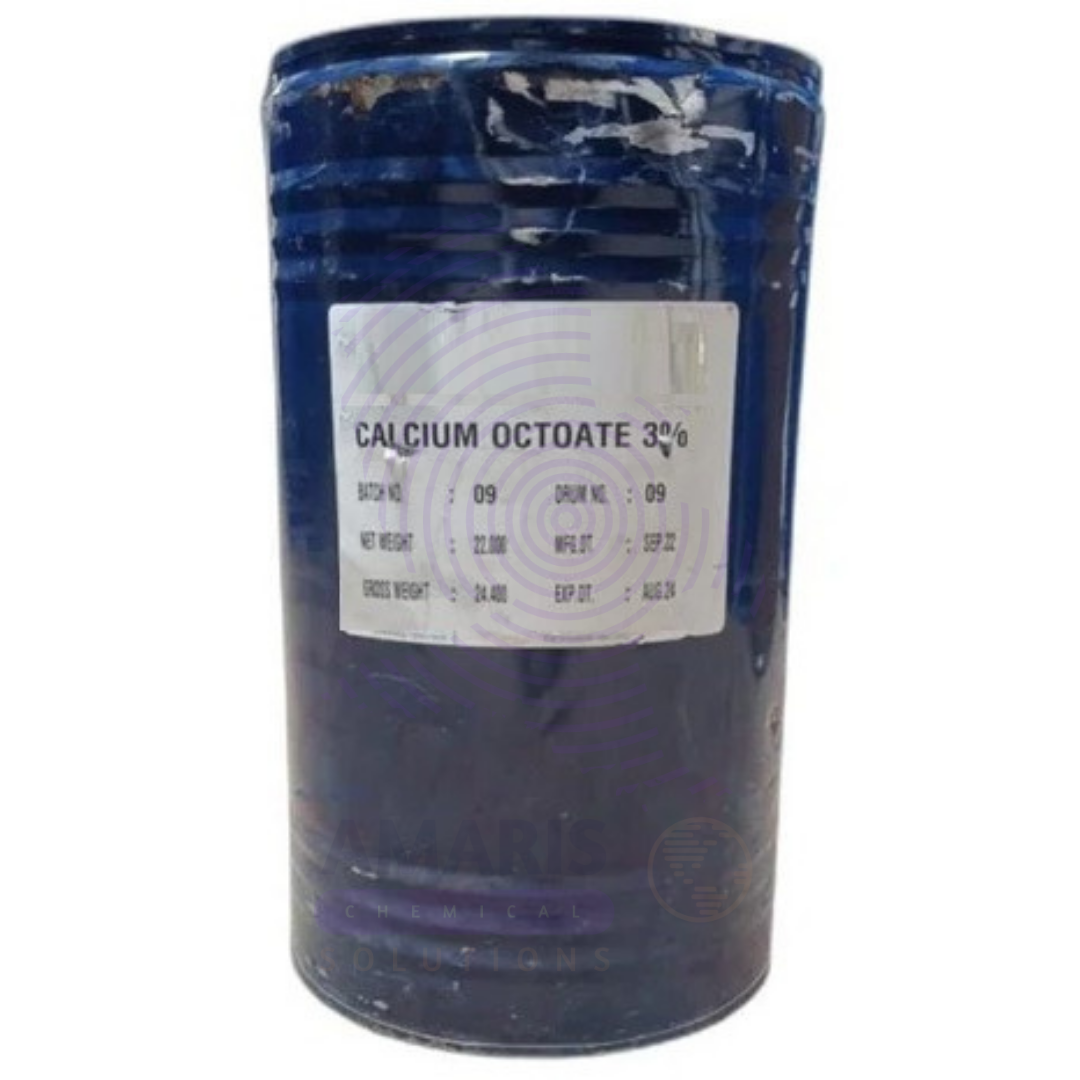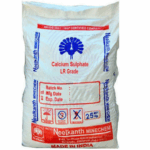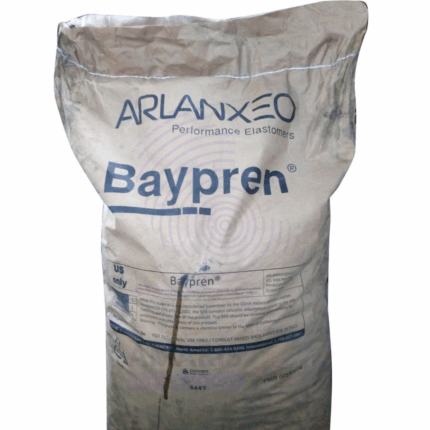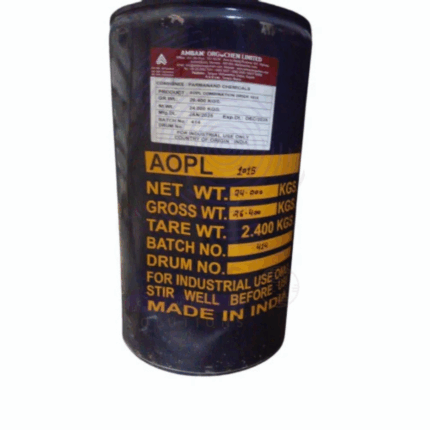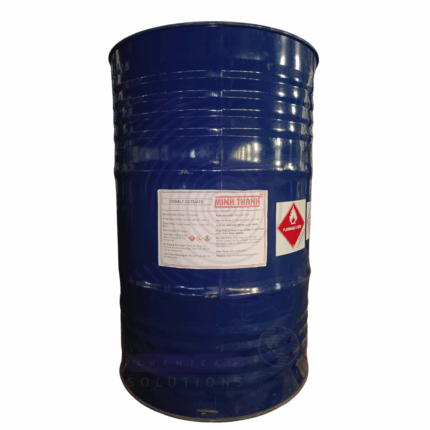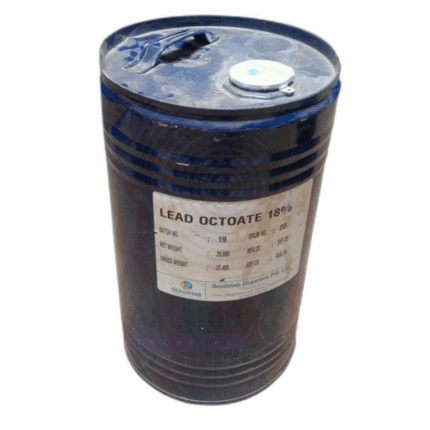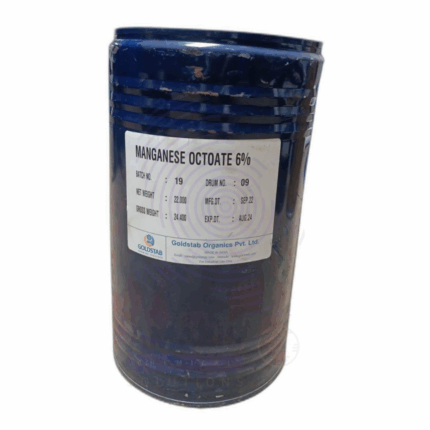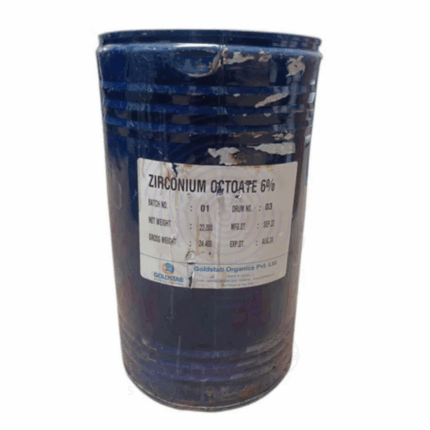Calcium Octoate
Whatsapp Order
Calcium Octoate 10% is an aqueous solution containing 10% calcium octoate, a calcium salt of 2-ethylhexanoic acid (octanoic acid). It is a white to pale yellow liquid, soluble in water, known primarily as a metal carboxylate used as a drying agent and corrosion inhibitor. It functions as a calcium-based drier in coatings, paints, varnishes, and printing inks to accelerate the curing process by catalyzing the oxidation and polymerization of drying oils. Due to its stability and efficacy at low concentrations, it is widely preferred as a non-toxic alternative to traditional lead or cobalt-based driers.
Description
Table of Contents
Toggle
Calcium Octoate
Primary Uses
- Coatings and Paint Industry
- Used as a calcium-based drying agent (drier) in alkyd, oil-based, and other air-drying paints and varnishes.
- Accelerates film formation by catalyzing oxidative cross-linking of drying oils, enhancing drying speed and surface hardness.
- Acts as a safer alternative to lead and cobalt driers with reduced toxicity concerns.
- Printing Inks
- Incorporated into printing inks to promote quick drying and improve film durability.
- Ensures faster handling and stacking time post-printing.
- Adhesives and Sealants
- Used as a curing accelerator in solvent-based adhesives and sealants containing drying oils or alkyd resins.
- Metal Protection
- Functions as a corrosion inhibitor in metal preservation formulations.
Secondary Uses
- Plastics and Rubber
- Sometimes used as a processing aid or stabilizer in certain plastic and rubber compounds.
- Textile Industry
- Utilized as a curing agent in textile printing inks and coatings.
- Chemical Intermediates
- Serves as a precursor or intermediate in synthesis of other metal soaps and additives.
KEY PRODUCT FEATURES
1. Basic Identification Attributes
- Chemical Name (IUPAC): Calcium 2-ethylhexanoate
- Common/Trade Name: Calcium Octoate 10%
- CAS Number: 19766-89-3 (calcium 2-ethylhexanoate)
- HS Code: 2915.70.00
- Molecular Formula: C16H30CaO4
- Synonyms:
- Calcium 2-ethylhexanoate
- Calcium octanoate
- Calcium octoate solution
2. Physical & Chemical Properties
- Physical State: Liquid (aqueous solution)
- Color & Odor: Clear to pale yellow; mild characteristic odor
- Density: Approx. 1.0 g/cm³ (varies slightly with concentration)
- Solubility: Completely soluble in water
- pH (10% solution): Typically 8–10 (slightly alkaline)
- Stability: Stable under normal storage conditions; resistant to hydrolysis
- Flash Point: Not applicable (aqueous solution)
3. Safety & Hazard Attributes
- Hazard Class (GHS): Not classified as hazardous under typical handling
- NFPA Ratings:
- Health: 1
- Flammability: 0
- Reactivity: 0
- Exposure Limits: No specific OSHA/ACGIH limits; avoid prolonged skin contact and ingestion
- Toxicity: Low toxicity; considered safer than heavy-metal driers
- Reactivity: Stable; avoid strong acids or bases which may hydrolyze the salt
4. Storage & Handling Attributes
- Storage Conditions: Store in tightly closed containers in a cool, dry, and well-ventilated area away from direct sunlight
- Container Type: Plastic or coated metal drums compatible with aqueous alkaline solutions
- Shelf Life: Typically 12–24 months if stored properly
- Special Handling: Use PPE; avoid eye and skin contact; prevent environmental discharge
5. Regulatory & Compliance Attributes
- FDA Status: Not typically regulated for food/pharma use; primarily industrial chemical
- REACH: Registered under EU chemical regulations
- Transportation: Not classified as dangerous goods under most transport regulations
- Waste Disposal: Dispose according to local environmental regulations for aqueous alkaline metal salts
6. Environmental & Health Impact
- Ecotoxicity: Low; readily disperses in aquatic environment, minimal bioaccumulation expected
- Persistence: Biodegradable in environment
- Bioaccumulation: Not expected
- Carcinogenicity/Mutagenicity: Not classified as carcinogenic or mutagenic
- Biodegradability: Biodegradable under aerobic conditions
SAFETY HANDLING PRECAUTIONS
Safety Handling Precautions
Personal Protective Equipment (PPE):
- Gloves
- Safety goggles
- Protective clothing
- Use respiratory protection if aerosolized
Handling Measures:
- Avoid inhalation and direct skin or eye contact
- Use in well-ventilated areas
- Avoid contamination of watercourses and soil
Storage Measures:
- Keep containers tightly closed
- Store away from acids and incompatible materials
- Protect from freezing and extreme heat
Hygiene Practices:
- Wash hands after handling
- Do not eat, drink, or smoke during handling
First Aid Measures
- Inhalation: Move to fresh air; seek medical attention if symptoms develop
- Skin Contact: Wash thoroughly with soap and water; remove contaminated clothing
- Eye Contact: Rinse immediately with plenty of water for at least 15 minutes; seek medical attention if irritation persists
- Ingestion: Rinse mouth with water; do not induce vomiting; seek medical attention if large amounts ingested
Firefighting Measures
- Fire Hazards: Not flammable
- Extinguishing Media: Use water spray, foam, dry chemical, or CO₂ for surrounding fire
- Special Precautions: Wear protective gear and self-contained breathing apparatus if involved in fire
- Decomposition Products: May release CO₂, CO, and calcium oxides on thermal decomposition
Related products
Bayprene
Bayprene is a high-quality, synthetic rubber polymer belonging to the class of nitrile butadiene rubbers (NBR). It is widely used for its excellent resistance to oils, fuels, chemicals, and abrasion, making it ideal for sealing, gasketing, hoses, and industrial applications where durability and chemical resistance are required. Bayprene exhibits good mechanical properties, high tensile strength, and resistance to swelling and degradation, especially in petroleum-based environments. It is commonly supplied as solid rubber sheets, molded parts, or raw polymer for compounding.
Cobalt Drier
Cobalt Drier is a metal-based drying agent primarily composed of cobalt salts (commonly cobalt octoate or cobalt naphthenate). It is widely used as a catalyst to accelerate the drying (oxidative curing) of oils, alkyd resins, and varnishes in coatings and paints. This drier promotes polymerization and cross-linking of unsaturated fatty acids in drying oils upon exposure to air, significantly reducing drying times and improving film hardness and durability. Cobalt driers are essential additives in industrial, decorative, and automotive coatings due to their effectiveness at low concentrations and compatibility with various resin systems.
Cobalt Octoate
Cobalt Octoate is a liquid metal drying agent solution consisting of 10% cobalt octoate dissolved in an organic solvent carrier (typically mineral spirits or similar hydrocarbon solvent). It functions as a highly efficient catalyst to accelerate the oxidative curing and drying of alkyd resins, oils, and varnishes in coatings and paints. By promoting cross-linking and polymerization of unsaturated fatty acids in drying oils upon exposure to oxygen, it significantly reduces drying time and enhances film hardness, gloss, and durability. Cobalt Octoate 10% is widely used in industrial and decorative coatings, inks, and adhesives, valued for its strong catalytic activity even at low concentrations.
Lead Octoate
Lead Octoate is a viscous liquid solution containing 30% lead octoate, a metal soap derived from lead and 2-ethylhexanoic acid (also known as octanoic acid). It is primarily used as a drying agent (drier) in paints, varnishes, and coatings to accelerate the curing process by promoting oxidation and polymerization of drying oils. This product is widely employed in industrial coatings to improve drying times, hardness, and durability of surface films. Packaged typically in 250kg drums, Lead Octoate 30% is handled with care due to the toxic nature of lead compounds.
Manganese Octate Drier
Manganese Octate Drier is a metal-organic compound commonly used as an oxidative catalyst in alkyd and oil-based coating systems. It is a manganese salt of 2-ethylhexanoic acid (octanoic acid) dissolved in a compatible organic solvent, typically white spirit or hydrocarbon thinner. At a 10% metal concentration, this drier functions as a primary oxidative (surface) drier, accelerating the polymerization and hardening of unsaturated oils and alkyd resins upon exposure to air. It exhibits a dark brown to violet color, has low viscosity, and is highly effective in small doses.
Paint Drier
Paint Drier is a specialized industrial additive designed as a non-toxic, lead-free alternative to traditional lead-based paint driers. It contains 36% active metal content primarily composed of bismuth and other metals, formulated to accelerate the drying and curing process of oil-based paints, varnishes, and coatings. The product improves film formation, reduces drying times, and enhances the durability and gloss of finished surfaces without the health and environmental hazards associated with lead compounds. BxPB36% Paint Drier is commonly used in architectural, industrial, and automotive coatings as a safer substitute for lead-based driers.
Zicronium Octoate
Zicronium Octoate is a metal carboxylate solution comprising zirconium ions complexed with octoic acid at an 18% zirconium concentration. It serves as an effective crosslinking and curing agent in coatings, adhesives, and sealants, enhancing film hardness, chemical resistance, and durability. This zirconium-based additive is valued for its catalytic properties in accelerating the curing of various polymer systems, especially in automotive and industrial applications.
Zinc Octoate
Zinc Octoate is a metal carboxylate solution containing approximately 10% zinc content, derived from zinc and 2-ethylhexanoic acid (octoic acid). It functions as an effective curing agent, catalyst, and crosslinker in various polymer systems such as paints, coatings, adhesives, and rubber compounds. This compound improves film hardness, drying times, and overall durability of finished products, making it widely used in industrial and manufacturing processes.


 Preservatives(food)
Preservatives(food) Flavor Enhancers
Flavor Enhancers Acidulants
Acidulants Sweeteners
Sweeteners Antioxidants
Antioxidants Colorants(food)
Colorants(food) Nutraceutical Ingredients (food)
Nutraceutical Ingredients (food) Nutrient Supplements
Nutrient Supplements Emulsifiers
Emulsifiers
 Collectors
Collectors Dust Suppressants
Dust Suppressants Explosives and Blasting Agents
Explosives and Blasting Agents Flocculants and Coagulants
Flocculants and Coagulants Frothers
Frothers Leaching Agents
Leaching Agents pH Modifiers
pH Modifiers Precious Metal Extraction Agents
Precious Metal Extraction Agents
 Antioxidants(plastic)
Antioxidants(plastic) Colorants (Pigments, Dyes)
Colorants (Pigments, Dyes) Fillers and Reinforcements
Fillers and Reinforcements Flame Retardants
Flame Retardants Monomers
Monomers Plasticizers
Plasticizers Polymerization Initiators
Polymerization Initiators Stabilizers (UV, Heat)
Stabilizers (UV, Heat)
 Antifoaming Agents
Antifoaming Agents Chelating Agents
Chelating Agents Coagulants and Flocculants
Coagulants and Flocculants Corrosion Inhibitors
Corrosion Inhibitors Disinfectants and Biocides
Disinfectants and Biocides Oxidizing Agents
Oxidizing Agents pH Adjusters
pH Adjusters Scale Inhibitors( water)
Scale Inhibitors( water)
 Antioxidants(cosmetic)
Antioxidants(cosmetic) Emollients
Emollients Fragrances and Essential Oils
Fragrances and Essential Oils Humectants
Humectants Preservatives
Preservatives Surfactants(cosmetic)
Surfactants(cosmetic) Thickeners
Thickeners UV Filters
UV Filters
 Fertilizers
Fertilizers Soil Conditioners
Soil Conditioners Plant Growth Regulators
Plant Growth Regulators Animal Feed Additives
Animal Feed Additives Biostimulants
Biostimulants Pesticides (Herbicides, Insecticides, Fungicides)
Pesticides (Herbicides, Insecticides, Fungicides)
 Active Pharmaceutical Ingredients (APIs)
Active Pharmaceutical Ingredients (APIs) Excipients
Excipients Solvents(pharmaceutical)
Solvents(pharmaceutical) Antibiotics
Antibiotics Antiseptics and Disinfectants
Antiseptics and Disinfectants Vaccine Adjuvants
Vaccine Adjuvants Nutraceutical Ingredients (pharmaceutical)
Nutraceutical Ingredients (pharmaceutical) Analgesics & Antipyretics
Analgesics & Antipyretics
 Analytical Reagents
Analytical Reagents Solvents(lab)
Solvents(lab) Chromatography Chemicals
Chromatography Chemicals Spectroscopy Reagents
Spectroscopy Reagents microbiology-and-cell-culture-reagents
microbiology-and-cell-culture-reagents Molecular Biology Reagents
Molecular Biology Reagents Biochemical Reagents
Biochemical Reagents Inorganic and Organic Standards
Inorganic and Organic Standards Laboratory Safety Chemicals
Laboratory Safety Chemicals Specialty Laboratory Chemicals(Special Laboratory Equipment)
Specialty Laboratory Chemicals(Special Laboratory Equipment)
 Demulsifiers
Demulsifiers Hydraulic Fracturing Fluids
Hydraulic Fracturing Fluids Scale Inhibitors(oil)
Scale Inhibitors(oil) Surfactants(oil)
Surfactants(oil) Drilling Fluids
Drilling Fluids
 Dyes and Pigments
Dyes and Pigments Bleaching Agents
Bleaching Agents Softening Agents
Softening Agents Finishing Agents
Finishing Agents Antistatic Agents
Antistatic Agents
 Admixtures
Admixtures Waterproofing Agents
Waterproofing Agents Sealants and Adhesives
Sealants and Adhesives Curing Compounds
Curing Compounds Concrete Repair Chemicals
Concrete Repair Chemicals Anti-Corrosion Coatings
Anti-Corrosion Coatings
 Surfactants(cleaning)
Surfactants(cleaning) Builders
Builders Enzymes
Enzymes Solvents (Cleaning)
Solvents (Cleaning) Fragrances
Fragrances
 Electronic Chemicals
Electronic Chemicals Catalysts
Catalysts Lubricants
Lubricants Photographic Chemicals
Photographic Chemicals Refrigerants
Refrigerants Automotive chemicals
Automotive chemicals Pyrotechnic Chemicals
Pyrotechnic Chemicals
 Biodegradable Surfactants
Biodegradable Surfactants Bio-based Solvents
Bio-based Solvents Renewable Polymers
Renewable Polymers Carbon Capture Chemicals
Carbon Capture Chemicals Wastewater Treatment Chemicals
Wastewater Treatment Chemicals
 Pigments
Pigments Solvents(paint)
Solvents(paint) Specialty Coatings
Specialty Coatings Binders/Resins
Binders/Resins Additives
Additives Driers
Driers Anti-Corrosion Agents
Anti-Corrosion Agents Functional Coatings
Functional Coatings Application-Specific Coatings
Application-Specific Coatings
 Fresh Herbs
Fresh Herbs Ground Spices
Ground Spices Whole Spices
Whole Spices Spice Blends
Spice Blends Dried Herbs
Dried Herbs
 Leavening Agents
Leavening Agents Dough Conditioners
Dough Conditioners Flour Treatments
Flour Treatments Fat Replacers
Fat Replacers Decoratives
Decoratives Preservatives(baking)
Preservatives(baking)
 Plasticizers & Softeners
Plasticizers & Softeners Reinforcing Agents
Reinforcing Agents Adhesion Promoters
Adhesion Promoters Vulcanizing Agents
Vulcanizing Agents Antidegradants
Antidegradants Blowing Agents
Blowing Agents Fillers & Extenders
Fillers & Extenders Accelerators & Retarders
Accelerators & Retarders